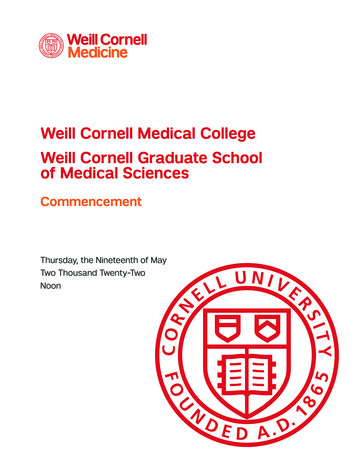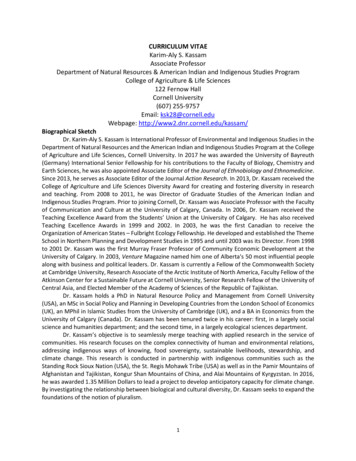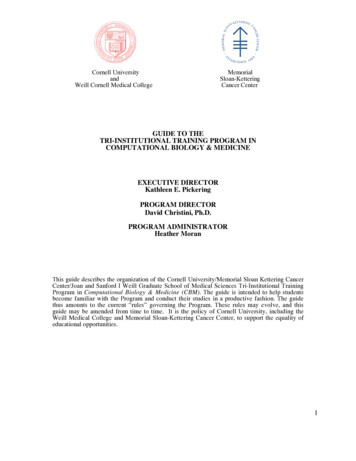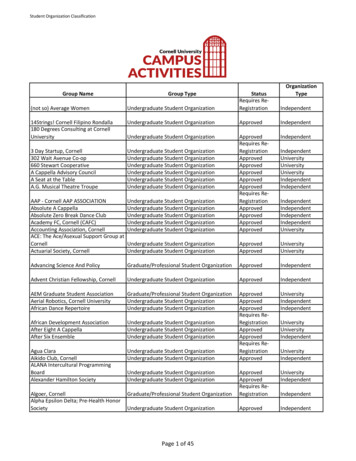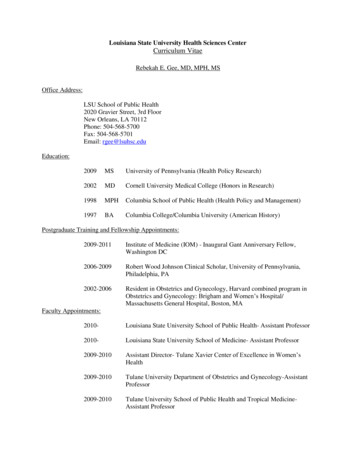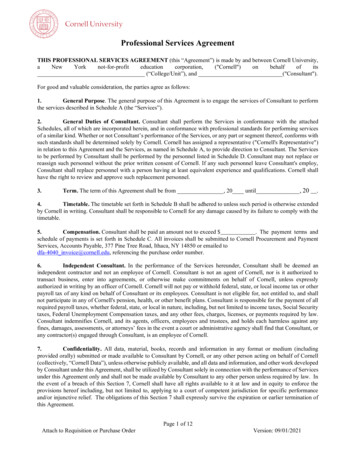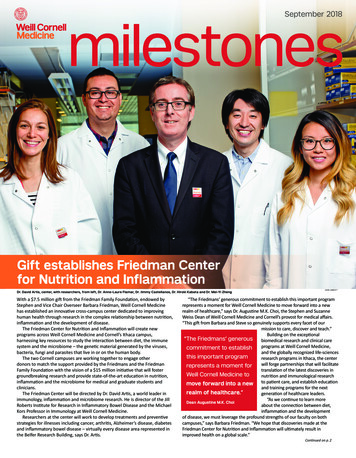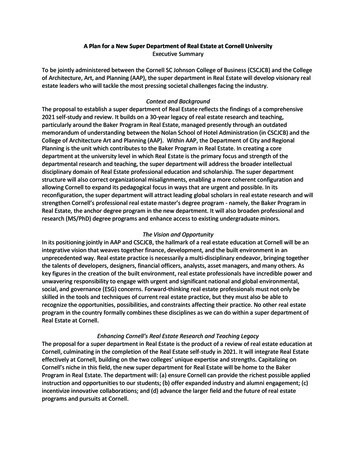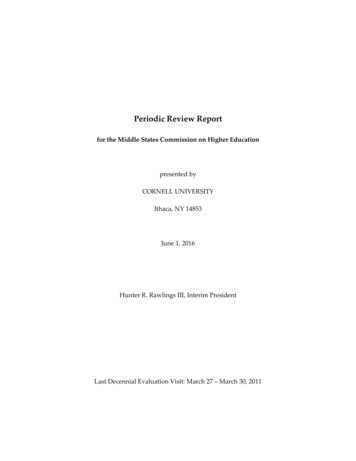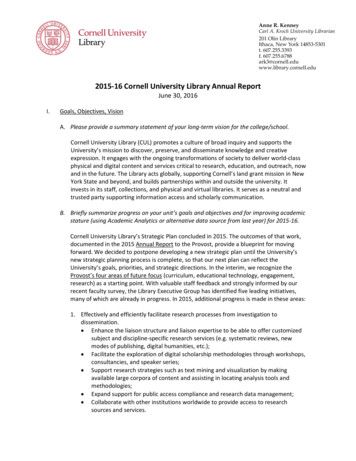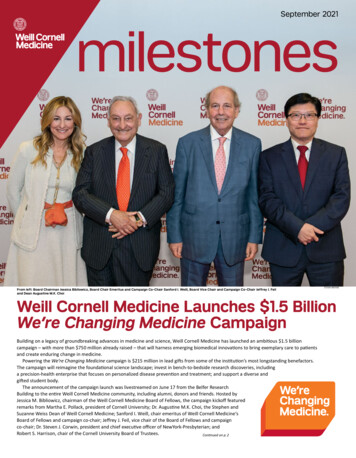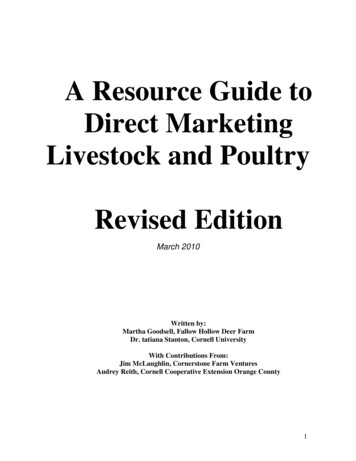
Transcription
A Resource Guide toDirect MarketingLivestock and PoultryRevised EditionMarch 2010Written by:Martha Goodsell, Fallow Hollow Deer FarmDr. tatiana Stanton, Cornell UniversityWith Contributions From:Jim McLaughlin, Cornerstone Farm VenturesAudrey Reith, Cornell Cooperative Extension Orange County1
Revisions were funded in part by the Niche Meat Processors Assistance Network and theNew York State Grazing Lands Conservation Initiative. The initial paper was funded in part by aFood and Industry Development Grant received from the New York State Department ofAgriculture and Markets and through the contributions of NY Farms!, Cornell UniversityDepartment of Animal Science and Fallow Hollow Deer Farm.Many thanks are due Clarence Davis, Supervising Food Inspector, New York StateDepartment of Agriculture and Markets Division of Food Safety and Inspection for meeting with uson numerous occasions and answering our hundreds of questions.The New York Small Farm Work Team on Livestock Processing Issues spent numerous hours listening toproducers and processors, understanding the issues, speaking with regulators, and reading the law andregulations. The Work Team provided a significant amount of input, suggestion, and feedback on thisproject. The Work Team was funded (2006-2009) by the Cornell Small Farm Program and we aregrateful for the support received from Dr. Anu Rangarajan, Violet Stone and Erica Frenay.Members of New York Small Farm Work Team on Livestock Processing Issues Dr. tatiana Luisa Stanton, Cornell Animal Science./farmer (TEAM CO-LEADER)Martha Goodsell, Fallow Hollow Deer Farm (TEAM CO-LEADER)Dr. James Hayes, Sapbush Hollow Farm (farmer/ processor)Kathleen Harris, Northeast Livestock Processing Service Company / farmerMarty Broccoli, CCE Oneida CountyTom Gallagher, CCE Albany CountyAudrey Reith, CCE Orange CountyLynn O’Brien, CCE Allegany County / Wild Geese FarmKirby Selkirk, NY Farm Bureau / farmerDenny Shaw, Cornell University Meats LabEric Shelley, SUNY Cobleskill Meats Lab / Cowboy Custom Cutting (processor)Jim McLaughlin, Cornerstone Farm VenturesEd Roggen (processor / farmer)Richard Beckwith, Hilltown Pork (processor)Terry Shaff, Shaff’s Custom Meats (processor)Heather Sanford, The Piggery (farmer/ processor)Michael Gloss, King Bird Farm (farmer/ processor) At length members:Bob Comis, farmerTracy Frisch, farm advocate / journalistLisa Engelbert, NOFA-NY/ Engelbert FarmsBernadette Logazar, CCE Franklin CountyCarol Gillis, NY Beef CouncilWarren Brannan, NYS Meat Processors AssociationConnie Kelley, Kelly’s Slaughterhouse (processor)Ivan Grizzly, Grizzly’s Custom Cutting (processor)John Campany, Croghan Meats (processor)Debra Ball, Eagle Bridge Custom Meats (processor)2
Resource Guide to Direct Marketing Livestock and PoultryTABLE OF CONTENTSIntroduction to Meat Regulation.8Why We Decided to Undertake This Project .8Why Inspections are Important and the History of Federal Inspection .8Compliance Versus Circumventing.9How Regulations are Classified .10Are the Animals Amenable, Non-amenable, or Poultry? .10Why Identifying a Market Channel is Important.12What is Commerce?.13Intrastate or Interstate? .13Import or Export? .14Religious Exemptions, Certifications, and Cultural Practices.15New York’s Kosher Law Protection Act of 2004.16New York’s Halal Foods Protection Act of 2005.17Cultural Practices.17Federal, State, or Custom: What is the Difference? .18USDA Inspected Meat Processing Facilities .18State or Local Inspected “Custom Exempt” Slaughterhouses .195-A Non-Amenable Slaughtering and Processing Facilities .205-A Poultry Slaughtering and Processing Facilities .215-A Facility Design and Location.2120-C Meat Processing Facilities .22Meat Lockers .23Other Types of Slaughter Houses Not Available in New York.24Retail-Exempt .24Talmadge-Aiken Meat Plants .24State Licensed USDA Equivalent Slaughterhouses.24Who are the Responsible Parties of the Tiered System?.27Food and Drug Administration (FDA) .27USDA Food Safety and Inspection Service (FSIS).28Other Federal Agencies .28Other State and County Agencies.29Handling Slaughter Animals.30Humane Handling.30Humane Transport .31Movement of Non-Ambulatory Animals to Slaughter .31How Many Animals Can Be Loaded on a Trailer? .32Acting as a Livestock Hauler.34Holding Animals.34Shrinkage of Animals in Transit.34Field Harvesting.35Animal Identification and Health Records.35Why Keep Records? .35Animal Health Treatment Records .363
Aging an Animal Without a Birth Certificate Through Dentition.38Slaughtering, Cutting, and Processing.40Slaughtering, Cutting, and Processing of Amenable Meats: .40Selling the Live Animal Direct to Consumers as “Freezer Meat”.40On-Site Slaughter for Entire Animals Sold Live .41Offal Disposal and On-Farm Composting.41If Selling Amenable Red Meat Wholesale, Retail and/or Direct to the Consumer .42Slaughter Requirements.42Amenable Meat Processing Options.43Organ Meats and Specified Risk Materials .43Slaughtering, Cutting, and Processing of Non-Amenable Meats and Poultry .46NYS Requirements for Large Farm Raised Game .46NYS Requirements for Farm Raised Rabbits .48NYS Requirements for Non-Amenable Poultry .49Value Added Products From Non-Amenable Meats .49FDA Requirements when Raising Non-Amenable Game .50Slaughtering, Cutting and Processing of Poultry.52Ratites .52Poultry Exemptions At a Glance .53Poultry Exemptions From Federal Inspection .54Personal Use Exemption.54Custom Slaughter/Processing Exemption.54Poultry Processed for In-State Market Channels.55Producer/Grower – 1000 Bird Limit Exemption. .55Producer/Grower or Other Person (PGOP) Exemption - 20,000 LimitExemption.57Producer/Grower – 20,000 Limit Exemption .57Small Enterprise Exemption – 20,000 Limit Exemption.58Retail Exemptions (Store/Dealer/Restaurant).59Retail Dealer Exemption.59Retail Store Exemption .59Retail Restaurant Exemption .60Mobile Slaughtering and/or Processing .62Poultry.62Mobile Facilities for Marketing Under the 1000 Bird Exemption .62Mobile units for custom slaughter/processing .63Mobile units for NY 5-A poultry plants .63Mobile units for USDA federal inspected or USDA equivalent poultry plants .66Red Meat Mobile Units .66Custom slaughter/processing .66Retail Meat Processing (20-C).665-A Non-Amenable Meats.68USDA federally inspected or USDA equivalent plants.69The Cuts.72Butchering Step By Step.72Industry Cutting Charts.734
Yields and Dressing Percentages .79Value Added Products.80FDA and Nitrate Usage .80Sausages, Smoked Meats and Dried Meats .81Fresh Sausages.81Cooked Smoked Sausages .81Fermented Sausages.81Smoked Meats and Sausages .82Jerky and Dried Meat.83Recipe Development and Considerations.83Casings.83Spice Selection.84Packaging Options .84Vacuum Packaging .84Labeling .85USDA Mark of Inspection and Establishment Number .86Safe Handling Instructions: Required for Raw Meat and Poultry .87Labeling of Additives .87Dating .88Nutrition Labeling .89Country of Origin Labeling .90UPC or Bar Codes .92Satisfying the Customer .92What Are The Differences Between Inspection & Grading? .92Beef.93Lamb .94Pork.94Goat.94Rabbit.96Poultry.96Quality Assurances .97Certification Programs and Product Claims.97Certified Organic .100Other Labels.101Wholesale Market Opportunities .103Marketing of Live Slaughter Animals .103The Players .103The Concern: Sufficient Supply .103A Farmer’s Legal Obligations .104Information and Responsibilities .104Legal Recourse in Case of Nonpayment.106Locating Buyers.106Marketing Carcasses Wholesale .107Retail Market Opportunities .108Direct Marketing Live Animals.109Live Animal Markets .1095
On-Farm Slaughtering .109Freezer Trade .110Auctions .112Retailing the Cuts .112Retail Markets: From the farm stand to the upscale grocery store .112Back porch/ Classic Farm-stand .113Farmers Markets .114Hotels, Restaurants and Institutions (HRI) .114Farm to School.115Fundraising Dinners.116Donations of Product .116Fairs and Festivals .116Mail Orders .116Finding a Specialty (Niche) Market for Meat and Poultry .117Safe Product Handling .119Temperature and the Cold Chain.119Transporting Products.119Storage .120Expiration Dates .120Safe Handling .121Mishandling .122Sampling and Slicing.122Additional Retailing Concerns.122Product Distribution.122Product Inventory and Record Keeping .123Premise Registration.123By Product Marketing Opportunities for Consideration.124Pet Food .125Whole Muscle Raw Meat as Pet Food.125FDA Regulation of Pet Food .127New York State Regulations.128Ensuring Meat Safety - HAACP, SOP and GMP .132Hazard Analysis Critical Control Points (HAACP) .132Introduction to HACCP .132Hazards .132Standard operating procedures (SOP) .133Good Manufacturing Practices (GMP).133End Product Testing .134Risk Management and Insurance Considerations for Farmers Selling Direct .134Risk Management .134Insurance.135General Liability Insurance .135Product Liability Insurance.135Licenses to Consider .135Food Establishment Licenses .135Article 20-C Food Processing Establishments .1366
Article 28 Retail Food Stores.136Article 28 Food Warehouses.136Article 17-B Food Salvager .136Article 19 Refrigerated Warehouse/Locker Plant:.136Article 5-C licensing of rendering plants.137Other Departments Farmers May Need to Contact .137State Jurisdiction.137County Jurisdiction.137Glossary Of Terms.138Glossary of Commonly Used Meat and Poultry Additives and Terms .144RESOURCES and REFERENCES.146Agencies to Contact for Additional Information .153Disclaimer Notice: In this publication, we provide information on additional resources and insome cases mention companies by name. Please note that it is not our intention to promote theseresources or businesses. Rather, by mentioning them, we are illustrating a point and providingexamples of products available.7
Introduction to Meat RegulationWhy We Decided to Undertake This ProjectThe purpose of this resource guide is to help New York farmers better understand the currentregulations governing the slaughtering, processing, and marketing of meat animals. Two waysfor farmers to realize higher returns for their farm products are to take over some of thetraditional roles of middlemen or to shift completely to direct marketing. However, meatregulations are complex. Accurately interpreting the statutes governing the processing and saleof meat animals – including poultry- and their products is more formidable for livestock farmersthan for their counterparts in fruit and vegetable production. Even experienced farmers can beconfused by the regulations. Without a clear understanding of what is and is not permitted undercurrent laws, many meat producers are hesitant to participate more directly in the marketing oftheir product. Instead, farmers may be limited to contract growing livestock for large corporatepackers, or selling slaughter animals through a shrinking number of local auctions and dealers.Both alternatives offer limited recourse to competitive pricing. This resource guide explains thecomplex meat laws in layman’s terms and clarifies the legal logistics of direct marketinglivestock and poultry. Ultimately, this should lead to a more direct market chain from farmer toconsumer in New York and hence, more local dollars circulating in local communities.Why Inspections are Important and the History of Federal InspectionWhy are regulations for the processing and marketing of meat more complex than those forvegetables and fruit? Many of the acute human health problems posed by fresh fruit andvegetables are caused by unsanitary water. Fortunately, in the United States, ample, potablewater is available and therefore fruits and vegetables are not considered a critical threat.However, unlike fruits and vegetables, health pathogens can multiply rapidly in animal productsthat are improperly handled.The United States acknowledged early on that poorly managed livestock and their products couldpose a threat for human health. In 1865, USDA Secretary Isaac Newton urged Congress to enactlegislation providing for the quarantine of imported animals. On May 29, 1884, PresidentChester Arthur signed the act establishing the Bureau of Animal Industry, which was theforerunner of Food Safety Inspection Service. The Bureau of Animal In
project. The Work Team was funded (2006-2009) by the Cornell Small Farm Program and we are and Erica Frenay. Processing Issues ornell Animal Science./farmer (TEAM CO-LEADER) (TEAM CO-LEADER) rmer/ processor) tock Processing Service Company / farmer nty ty ty / Wild Geese Farm er Lab
